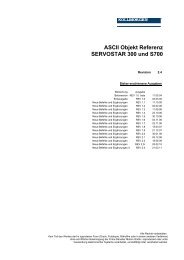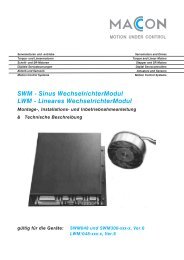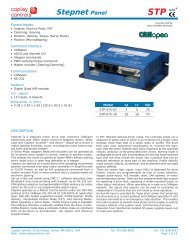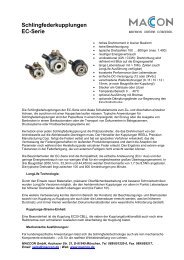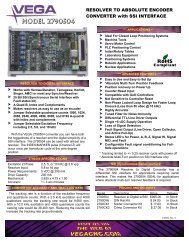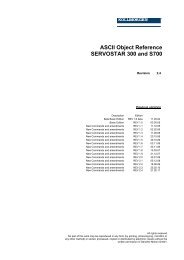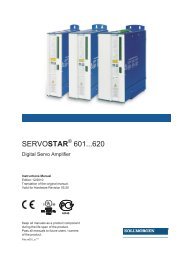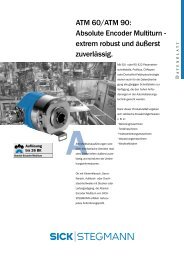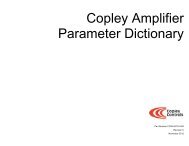CANopen Programmer's Manual - Maccon.de
CANopen Programmer's Manual - Maccon.de
CANopen Programmer's Manual - Maccon.de
You also want an ePaper? Increase the reach of your titles
YUMPU automatically turns print PDFs into web optimized ePapers that Google loves.
3: Device Control, Configuration, and Status <strong>CANopen</strong> Programmer’s <strong>Manual</strong><br />
INPUT MAPPING FOR CAN NODE ID INDEX 0X21B1<br />
Type Access Units Range Map PDO Memory<br />
Unsigned 32 RW - See Description, below. NO F<br />
Description<br />
When the <strong>CANopen</strong> Network Configuration object (in<strong>de</strong>x 0x21B0, p. 77) indicates that 1 or more<br />
input pins will be used to select the CAN no<strong>de</strong> ID, this mapping register is used to select which<br />
input pins will be mapped to which ID bit. Fields inclu<strong>de</strong>:<br />
Bit Description<br />
0-3 I<strong>de</strong>ntify the general purpose input pin associated with ID bit 0.<br />
4-7 I<strong>de</strong>ntify the general purpose input pin associated with ID bit 1.<br />
8-11 I<strong>de</strong>ntify the general purpose input pin associated with ID bit 2.<br />
12-15 I<strong>de</strong>ntify the general purpose input pin associated with ID bit 3.<br />
16-19 I<strong>de</strong>ntify the general purpose input pin associated with ID bit 4.<br />
20-23 I<strong>de</strong>ntify the general purpose input pin associated with ID bit 5.<br />
24-27 I<strong>de</strong>ntify the general purpose input pin associated with ID bit 6.<br />
28-30 Reserved for future use.<br />
31 Set to enable this register. Clear to use <strong>de</strong>fault mapping.<br />
If bit 31 is zero, then a <strong>de</strong>fault bit mapping is used and the rest of this register is ignored. The<br />
<strong>de</strong>fault bit mapping uses the top N input pins and maps them such that the high-numbered pins<br />
are used for higher-numbered bits in the ID. For example, the Accelnet panel amplifier has 12<br />
general purpose input pins (0 to 11). If 3 of these pins are used for ID configuration and the<br />
<strong>de</strong>fault mapping is used, then the highest 3 pins (9, 10 and 11) will be used for the ID. In this case,<br />
pin 9 is bit 0, pin 10 is bit 1 and pin 11 is bit 2. If bit 31 is set, then the rest of this register is used<br />
to <strong>de</strong>fine which input pin is assigned to which bit of the ID. The input pins are numbered from 0 to<br />
15 and each nibble of the register gives the input pin number associated with one bit of the ID.<br />
For example, if three input pins are configured for address selection and the mapping register is<br />
set to 0x80000012, then input pin 2 is used for ID bit 0, input pin 1 is used for ID bit 1, and input<br />
pin 0 is used for ID bit 2.<br />
Note that the CAN no<strong>de</strong> ID is calculated at startup only. The input pins assigned to the no<strong>de</strong> ID<br />
are sampled once during power up and used to calculate the ID. These pins may be assigned<br />
other uses after power up if necessary.<br />
CAN ID SELECTION SWITCH VALUE INDEX 0X2197<br />
Type Access Units Range Map PDO Memory<br />
Integer 16 RO - 0 - 15 YES -<br />
Description<br />
This object gives the current state of the CAN address switch. For amplifiers that do not have a<br />
switch, the value returned is un<strong>de</strong>fined.<br />
MULTI-MODE PORT CONFIGURATION INDEX 0X2241<br />
Type Access Units Range Map PDO Memory<br />
Unsigned 16 RW - - YES RF<br />
Description<br />
Multi-mo<strong>de</strong> Port Configuration. The available settings are:<br />
Value Description<br />
0 Output buffered primary enco<strong>de</strong>r (hardware buffering).<br />
1 Configure pins as inputs.<br />
2 Output simulated enco<strong>de</strong>r outputs tracking motor enco<strong>de</strong>r.<br />
3 Output simulated enco<strong>de</strong>r outputs tracking position enco<strong>de</strong>r.<br />
78 Copley Controls




